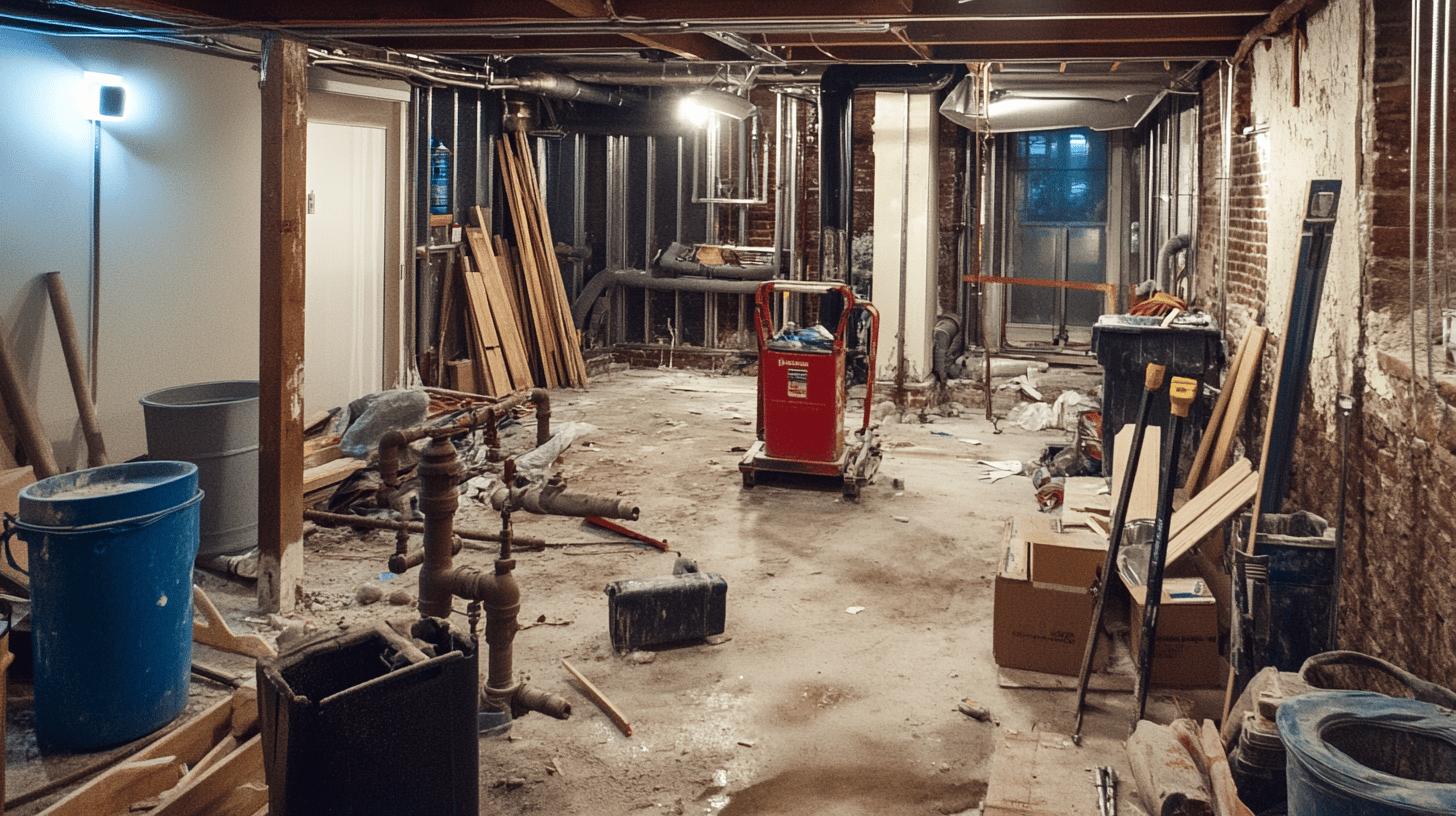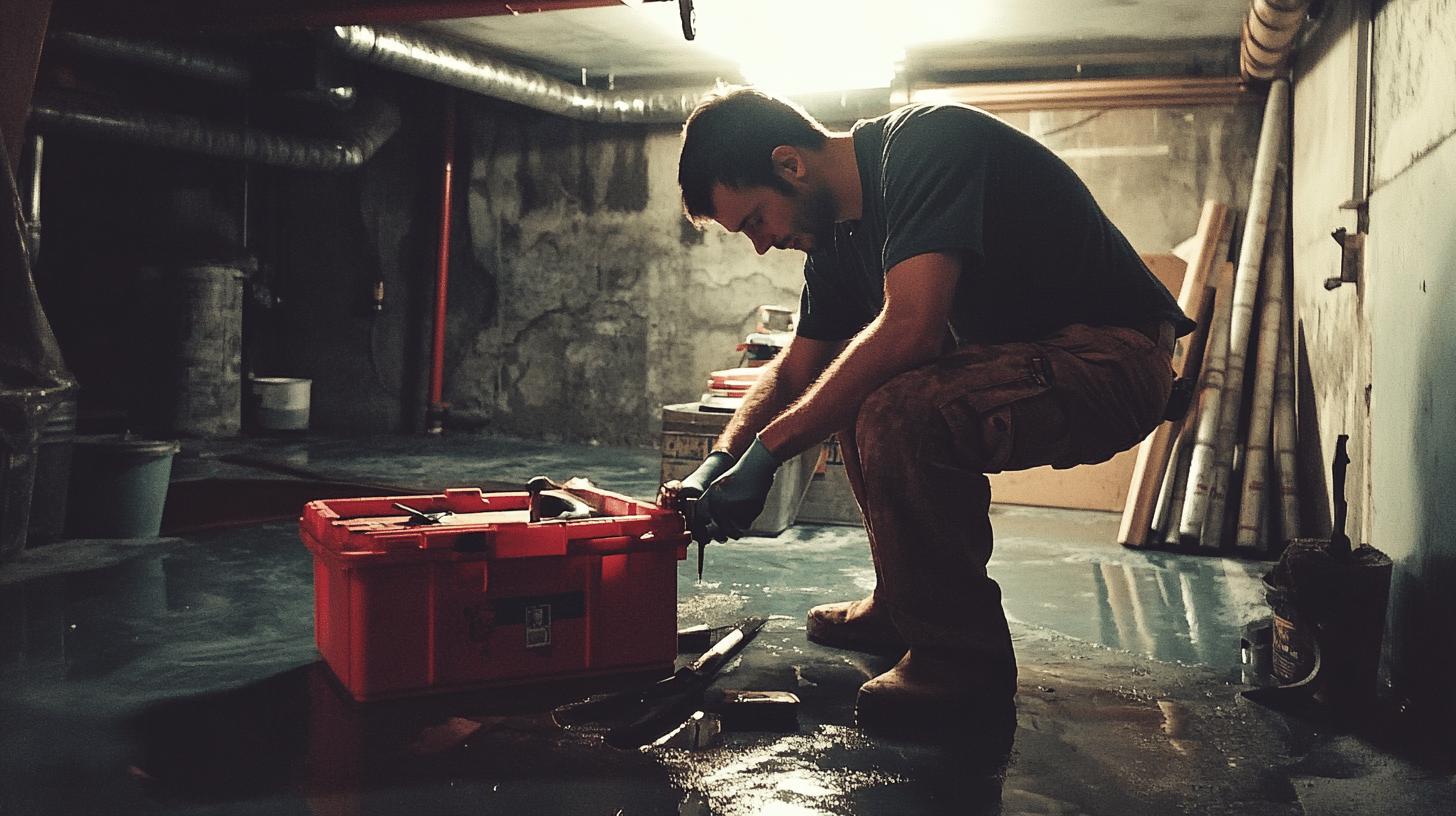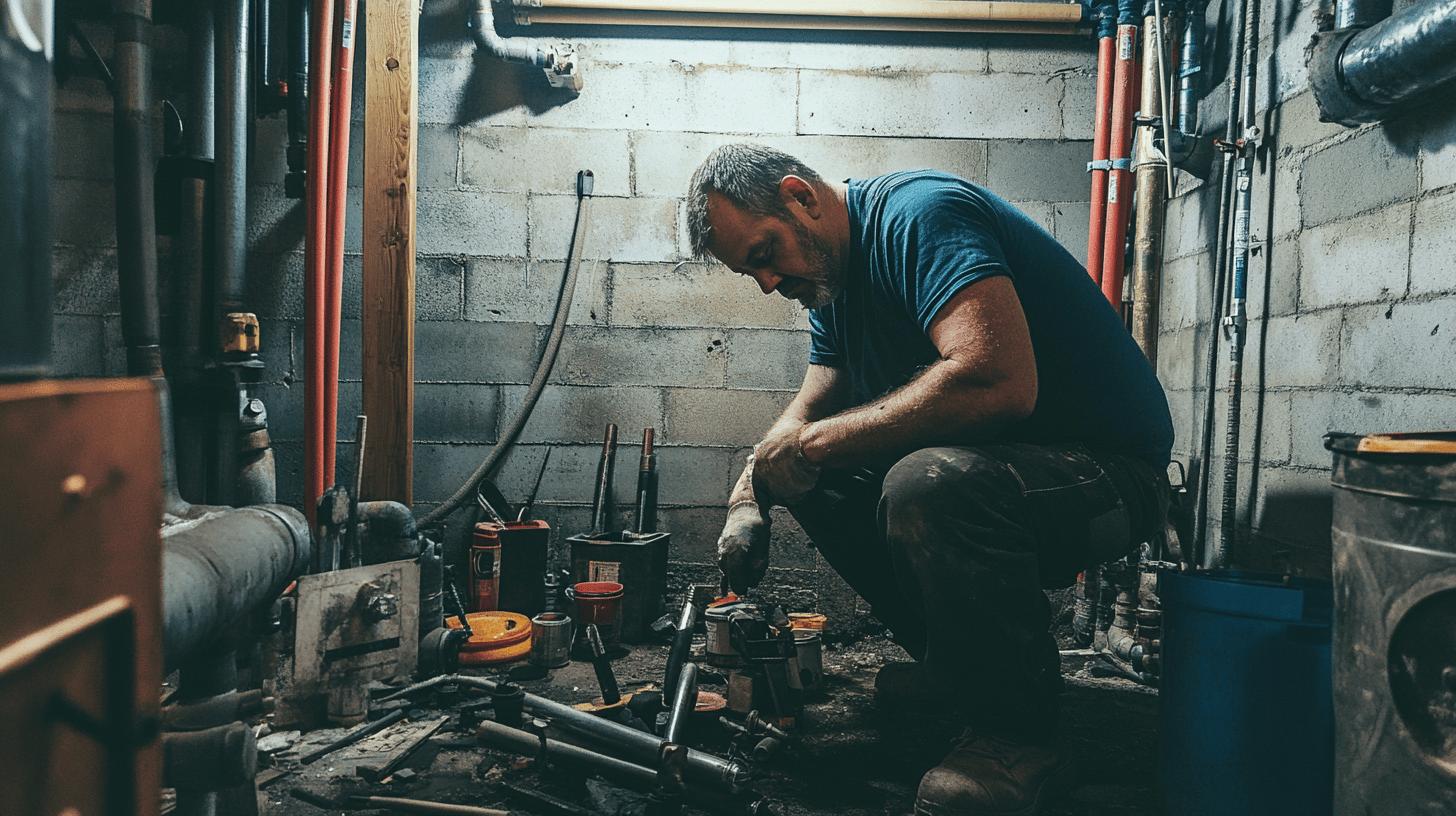TL;DR:
- Basement bathroom plumbing is complex; key steps include:
- Locate sewer stack
- Sketch layout plans
- Follow code requirements
- Decide on sewage pump needs
- Plan utility locations
- Obtain necessary permits (building, plumbing, electrical) to ensure compliance.
- Address drainage challenges with:
- Sewage ejector pumps
- Sump pumps
- Backwater valves
- DIY plumbing can save costs but risks mistakes; hiring professionals ensures safety and compliance.
- Costs range from $8,000 to $15,000, factoring in permits, materials, labor, and potential repairs, with a strong ROI for added basement bathrooms.
Wondering if plumbing a basement bathroom is doable? It might sound tricky because it involves working below ground, but with the right plan, it can be manageable. This article will walk you through the key steps, from checking out the existing utility layout to understanding local plumbing codes. Whether you’re thinking of tackling it yourself or hiring pros, knowing these basics is essential. Let’s dive in and show you how to approach your basement bathroom project with confidence, making what seems complicated a lot easier!
Planning the Plumbing for a Basement Bathroom
Planning the plumbing for a basement bathroom can be tricky, so you need to pay attention to the details. Start by figuring out where the existing utilities are, especially the sewer stack. This info is crucial because it tells you if you’ll need a pumping system, since basements are usually below the main sewer line. Smart planning ensures that the plumbing works with your basement layout, helping you avoid expensive mistakes.
- Locate sewer stack
- Sketch layout plans
- Follow code requirements
- Decide on sewage pump needs
- Plan plumbing and utility locations
Getting accurate measurements is super important when setting up utilities for a basement bathroom. Precision ensures everything fits together correctly. Before finalizing, dry fitting pipes and fixtures can help catch any mistakes. You might need to adjust existing utilities for new lines, and that can get complicated. It’s a good idea to hire professionals for these tasks to make sure everything is safe and meets local codes.
Navigating Basement Plumbing Codes and Permits

Knowing the local building codes is really important for plumbing a basement bathroom. Before you start any work, make sure to get permits for installing new water lines, drainage, and electrical connections. These permits ensure your project follows local safety standards, which can vary by area. Skipping this step could lead to fines and safety issues. It’s not just about following the law; it’s about making sure your plumbing system works efficiently and safely.
| Permit Type | Purpose |
|————-|———|
|Building Permit| Ensures structural compliance |
|Plumbing Permit| Verifies safe water and sewage connections |
|Electrical Permit| Confirms electrical safety and code adherence |
Getting a pro to handle your plumbing can make dealing with legal stuff a lot easier. Experienced plumbers know the local codes inside and out, which helps you dodge problems that could come from wrong installations. They’ll take care of submitting permits and making sure all the paperwork is right and done on time. This not only saves you time and hassle but also gives you peace of mind knowing your project is in good hands.
Overcoming Drainage and Sewage Challenges
Plumbing a basement bathroom comes with its own set of challenges since it’s located below ground. Unlike bathrooms on higher floors, gravity won’t help move waste and water to the main sewer line. That means you need effective solutions to ensure sewage flows properly and to avoid backups. Good planning and the right equipment, like pumps and smart plumbing layouts, are super important. If you don’t tackle these issues, you could end up dealing with regular drain problems.
- Use sewage ejector pumps
- Install sump pumps
- Implement backwater valves
- Choose proper pipe sizing and materials
- Ensure drainage slope
- Conduct regular maintenance
Sump pumps are a must-have for basement drainage. They help move wastewater from the basement to the main sewer line, tackling the challenges of being below ground. Having backup systems, like battery-powered backups for the pumps, can prevent flooding if the power goes out. These solutions keep your basement plumbing safe from common problems and ensure your drainage system works reliably.
Professional vs. DIY Plumbing in the Basement

Is basement bathroom plumbing easy? Not really. It comes with challenges like breaking through concrete and connecting electrical circuits, which require skill and precision. Since basements are below ground, drainage is trickier, making careful planning and special equipment a must. Because of these factors, the project can be tough and often needs experienced hands to ensure everything’s done safely.
Hiring a professional plumber has many benefits. They have the experience to install water lines and wiring according to local codes. Plus, they’re prepared for unexpected issues, like rerouting plumbing around obstacles. Their expertise reduces the chances of future problems, so you can trust that your plumbing will work reliably.
A DIY approach might sound tempting for saving on labor costs. With some research and the right tools, homeowners could tackle easier tasks like pipe installation. But handling tougher jobs, like breaking through concrete, can be overwhelming for those without training, leading to mistakes and safety risks.
Cost is also a big factor in deciding between going pro or doing it yourself. DIY might save you some cash at first, but fixing mistakes can end up costing more than hiring a professional in the first place. While hiring a pro might seem pricey upfront, the long-term savings from having efficient and code-compliant installations are worth it. Pros offer a reliable and cost-effective solution for the complexities of basement bathroom plumbing.
Cost Considerations for Basement Bathroom Plumbing
Installing a basement bathroom is a solid investment, usually costing between $8,000 and $15,000. The price varies based on how complicated the project is and the current plumbing setup. If you have a newer home with rough-in drain systems, you could save around $1,000. Even though the initial costs might seem high, adding a basement bathroom increases your home’s value and offers a good return on investment.
- Plumbing fixtures and materials
- Professional labor costs
- Permit and inspection fees
- Tools and equipment
- Potential repairs or modifications
When budgeting for your basement bathroom, make sure to account for all expenses. Set aside money for plumbing fixtures since they’re essential for both function and style. If you’re hiring professionals, remember that their services add to labor costs but ensure safe installations. Don’t forget about permit and inspection fees, which are necessary. If you’re planning to do some work yourself, you might need to invest in tools too. It’s also smart to include a buffer for unexpected repairs since surprises can pop up. With strategic planning, you can manage costs effectively and boost your home’s value.
Final Words
Turning a basement into a usable bathroom requires careful planning and knowing where utilities are located. You’ll need to follow local plumbing codes and get the necessary permits while ensuring effective drainage solutions are in place. Whether you decide to take this on yourself or hire professionals depends on your skills and comfort level with complex tasks like sewage management. Costs can vary, but the potential increase in your home’s value makes this investment worthwhile. So, if you’re wondering, “Can you plumb a bathroom in the basement?” remember that with the right planning, it can be a great way to enhance your space and boost your home’s value.
FAQ
Can you put plumbing in a basement?
Plumbing can be added to a basement, but it often requires special considerations such as identifying utility locations, possibly installing a sewage pump, and adhering to specific building codes.
Can I put a full bathroom in my basement?
Yes, a full bathroom can be installed in a basement. This involves careful planning for proper drainage, plumbing lines, and meeting local building codes.
Is it expensive to add a bathroom to a basement?
Adding a bathroom to a basement is often costly, typically ranging from $8,000 to $15,000. Costs depend on factors like labor, materials, and whether a sewer ejector pump is needed.
Can you install a basement bathroom without breaking concrete?
It is possible to install a basement bathroom without breaking concrete using above-floor plumbing systems or installing sewage ejector pumps to manage drainage and sewage disposal.
What does basement rough-in plumbing look like?
Basement rough-in plumbing typically includes pre-installed pipes that exit through the floor, ready for connection to fixtures, potentially reducing installation costs.
How to put a bathroom in a basement without plumbing?
To add a bathroom in a basement without existing plumbing, consider using an above-floor plumbing system that minimizes disruption to existing infrastructure.
What are the cheapest ways to put a bathroom in a basement?
The cheapest methods include utilizing existing plumbing, opting for budget-friendly materials, and potentially reducing labor costs with DIY efforts if feasible. Hiring a professional can provide a balance of cost-efficiency and compliance.

